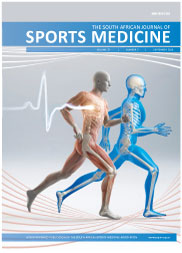Prevalence of overweight and obesity in grade 1 learners in the North West Province of South Africa: The NW-CHILD Study
DOI:
https://doi.org/10.7196/SAJSM.519Abstract
Objectives. To determine the prevalence of overweight and obesity among grade 1 learners, taking into account age, gender, race and school socioeconomic profile. Methods. The study is based on the baseline prevalence of overweight and obesity as part of the ongoing 6-year longitudinal NW Child Health Integrated Learning and Development (NW-CHILD) study. Stratified random sampling was used to identify 20 schools from four educational districts across all five quintiles of schools in the North West Province (NWP) of South Africa (SA). A total of 816 (419 boys, 397 girls) grade 1 learners with a mean age of 6.80 (standard deviation 0.39) years participated in the study, including 567 black learners, 218 white learners and 31 learners from other race groups. Standard anthropometric techniques and international body mass index (BMI) cut-off points for children were used to determine overweight and obesity. Results. A combined prevalence of overweight and obesity (Ow/Ob) of 11.1% was found, of which 7.5% were overweight and 3.6% obese. Although 7-year-old children showed a significantly higher prevalence of overweight (10.5%) than 6-year-old children (6.3%; p<0.05), obesity levels were more prevalent among 6-year-old children (4.7%) than 7-year-old children (2.3%). Although not significant, a higher prevalence of overweight (9.3 v. 6.4%) and obesity (4.3% v. 3.3%) was found in girls than boys. For the whole sample, white children displayed a significantly higher prevalence of Ow/Ob compared with black children (19.7% v. 8.8%; p<0.05), and the prevalence of Ow/Ob was higher in 4th- (18.1%) and 5th- (21.2%) quintile schools (which are associated with higher socioeconomic status (SES)) than in quintile 1 to quintile 3 schools (5.1%, 8.7%, 6.1%, respectively; p<0.05). Conclusions. More than 10% of grade 1 learners in the NWP of SA were overweight or obese, with the prevalence being significantly lower in lower SES schools and among black children. Prevention strategies are needed to combat overweight and obesity, and the associated negative consequences of these health risks. Obesity levels in black children should also be monitored because of continuing economic transition, and taking into account increasing overweight and obesity in black South African adults.Downloads
Downloads
Published
2014-12-15
Issue
Section
Articles
License
Copyright (c) 2014 South African Journal of Sports Medicine

This work is licensed under a Creative Commons Attribution 4.0 International License.
The South African Journal of Sports Medicine reserves copyright of the material published. The work is licensed under a Creative Commons Attribution 4.0 (CC BY 4.0) International License. Material submitted for publication in the South African Journal of Sports Medicine is accepted provided it has not been published elsewhere. The South African Journal of Sports Medicine does not hold itself responsible for statements made by the authors.
How to Cite
Pienaar, A. E. (2014). Prevalence of overweight and obesity in grade 1 learners in the North West Province of South Africa: The NW-CHILD Study. South African Journal of Sports Medicine, 26(4), 109-114. https://doi.org/10.7196/SAJSM.519
Views
- Abstract 705
- PDF 558
Metrics

- Citations
- Citation Indexes: 4
- Usage
- Full Text Views: 2100
- Abstract Views: 331
- Captures
- Readers: 23





.png)